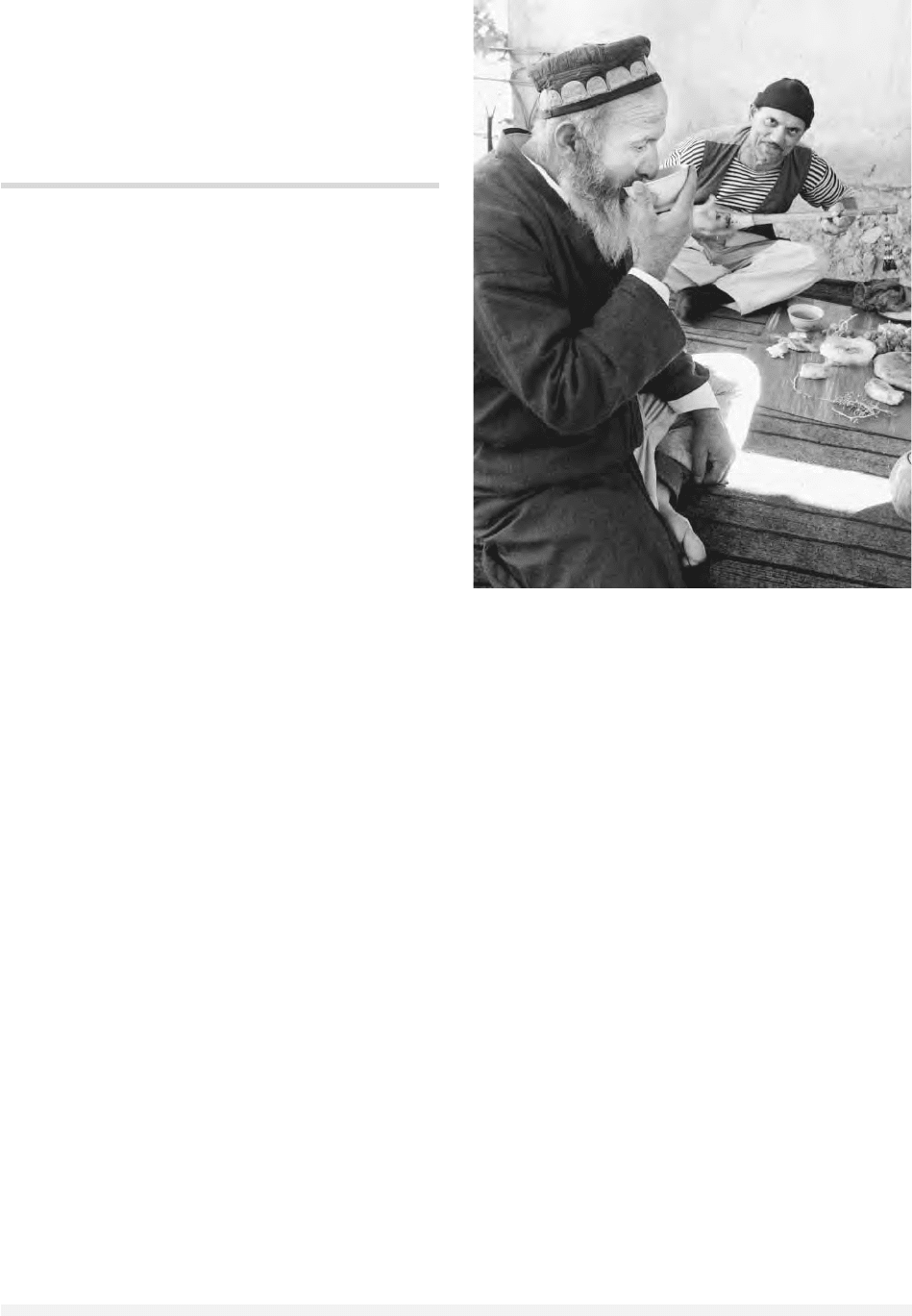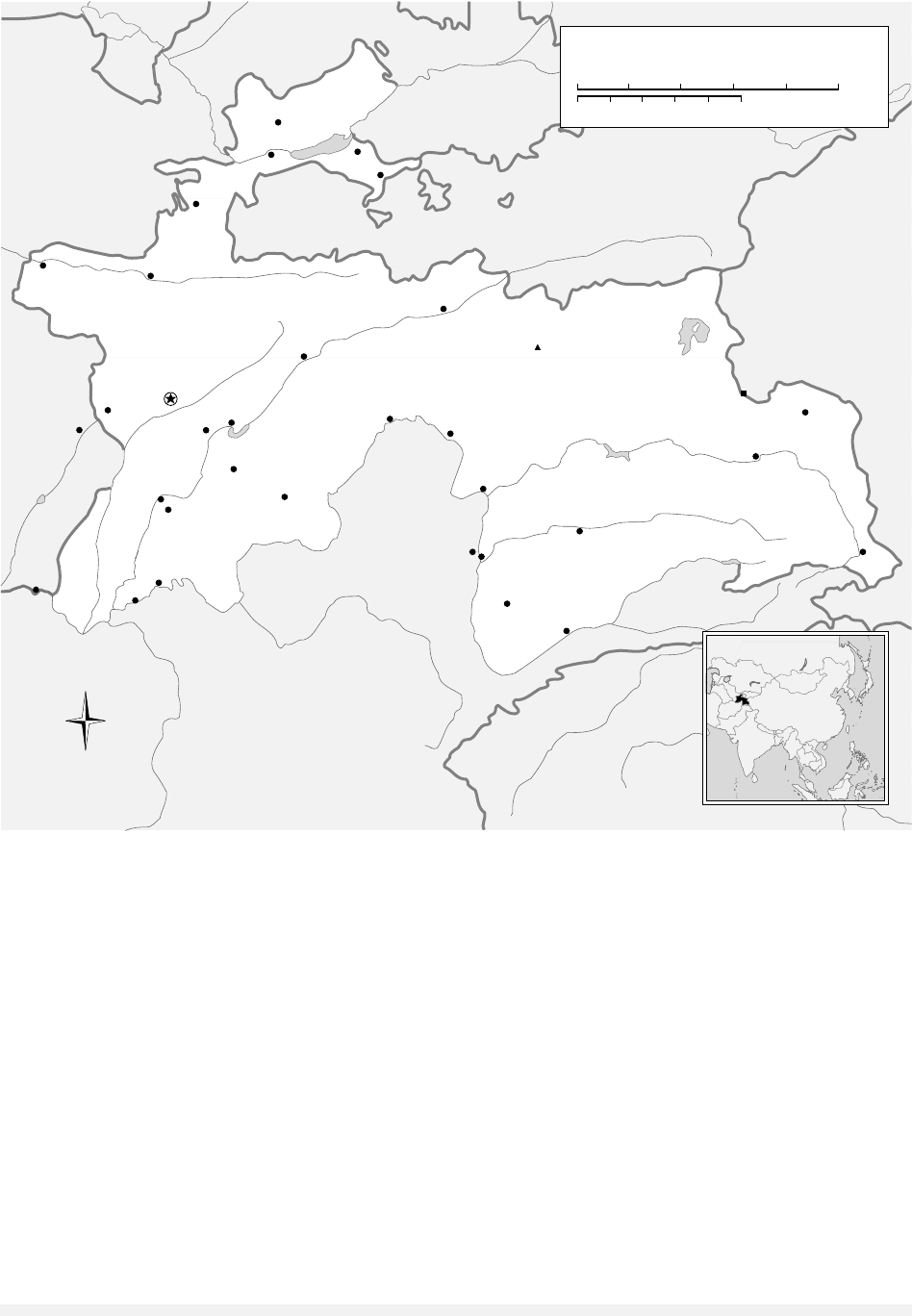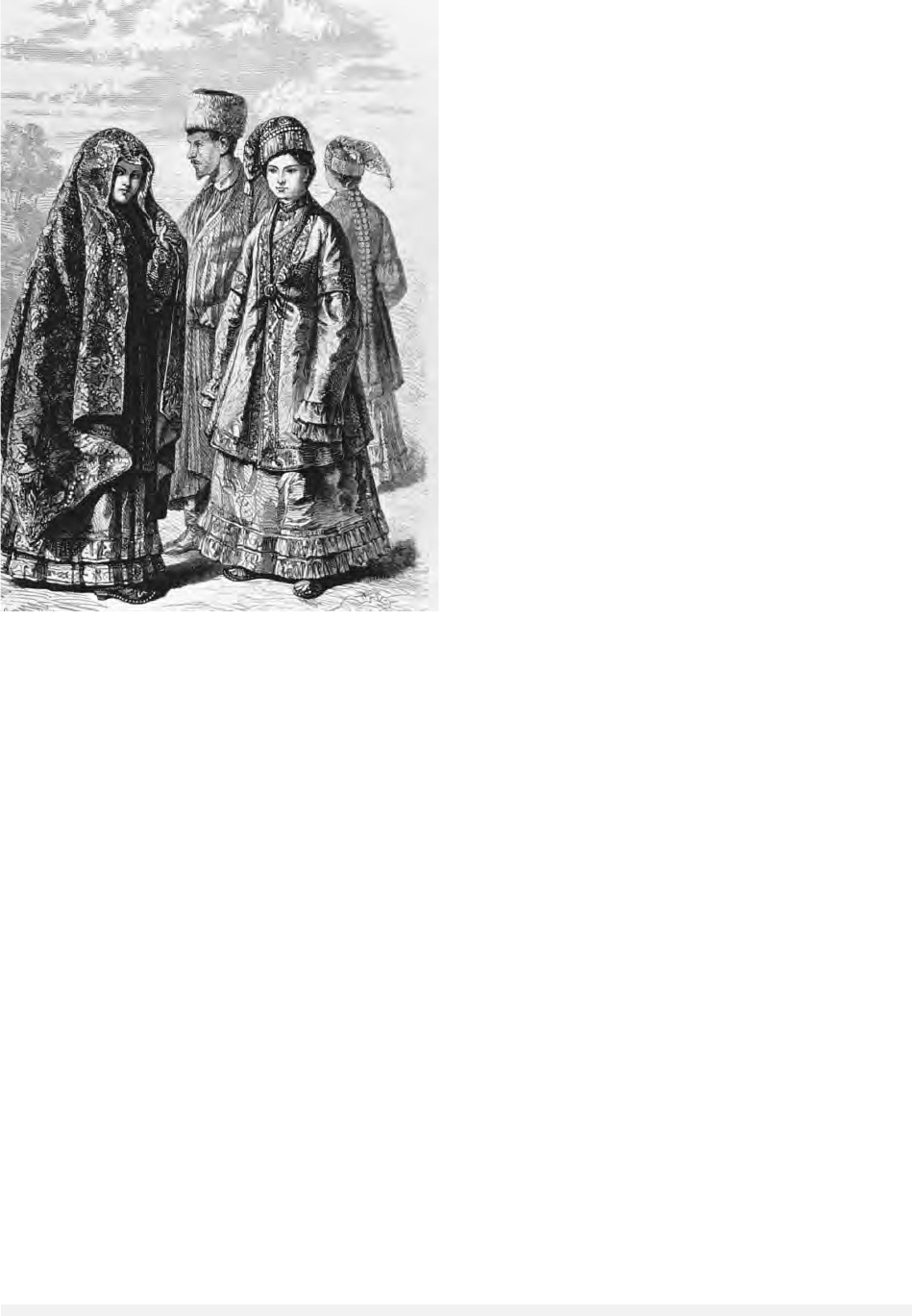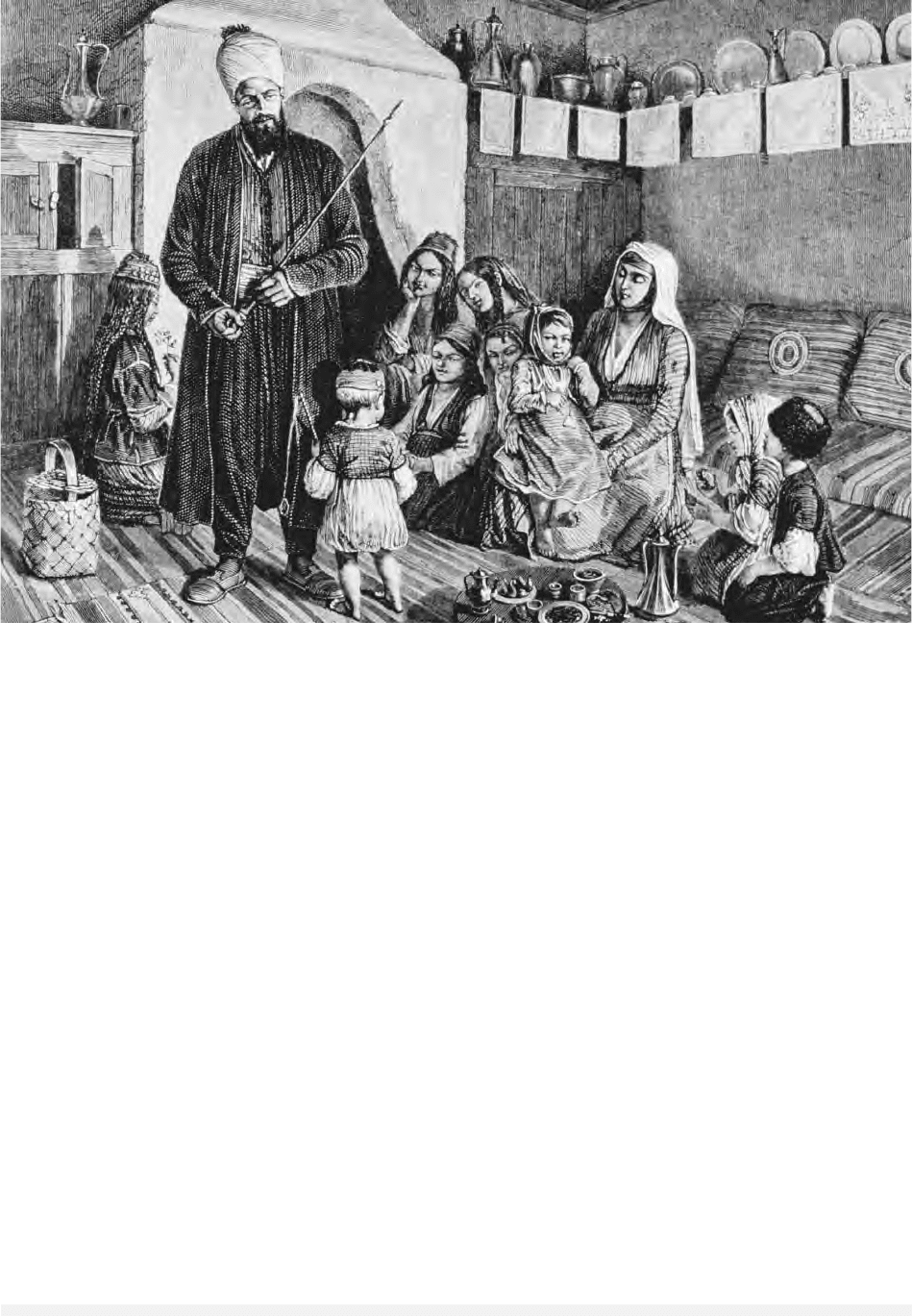Encyclopedia of Russian History
Подождите немного. Документ загружается.


Gershkovich, Alexander. (1989). The Theater of Yuri Lyu-
bimov: Art and Politics at the Taganka Theatre in
Moscow. New York: Paragon House.
M
AIA
K
IPP
TAJIKISTAN AND TAJIKS
The Tajiks are the most prominent indigenous non-
Turkic population in Central Asia. They are of Per-
sian/Iranian ethnic descent, although their exact
origin is subject to debate. Legends link the Tajiks
with Alexander the Great and his campaign in the
region north of Afghanistan and west of China—
what is today Tajikistan. More likely, contempo-
rary Tajiks are descendants of the Persian-speaking
population that resided in the sedentary regions of
what is now Central Asia, particularly in the coun-
try of Tajikistan.
Tajikistan had a population of 6,719,567 in
2002, of which approximately 4,361,000 were eth-
nic Tajik (64.9%). However, if one adds to that the
million or so Tajiks that live in Uzbekistan and
Afghanistan, respectively, the number increases to
well above six million Tajiks in Central Asia. What
makes these calculations difficult is the fact that
defining oneself as a Tajik is a construct of the So-
viet era. Prior to the early twentieth century, peo-
ple in the region defined themselves more on tribal
and clan affiliations or by their adherence to Islam
than to an ethnic identity. In neighboring Uzbek-
istan, for example, ethnic Tajiks claim that they are
actually more prominent than the official statistics
of that country suggest. Within the Republic of
Tajikistan, other significant minorities include
Uzbeks (25.0%) and Russians (3.5%). Many Rus-
sians emigrated from Tajikistan immediately after
the break-up of the Soviet Union, particularly dur-
ing the period of the civil war (1992–1997). Most
of the Uzbeks live in the northern region of Sogd,
previously known as Leninobod (Leninabad). The
remaining Russians live in the capital city of
Dushanbe, which in 2002 had an overall popula-
tion of 590,000, although that figure undoubtedly
was an underestimation.
The Tajiks speak an eastern dialect of Farsi, the
language of Iran. The languages are mutually in-
telligible; although as modern Tajik is written in
the Cyrillic script and not in the Arabic script, there
can be difficulties between the two. Indeed,
throughout the past century, Tajik has been writ-
ten in Arabic, Latin, and Cyrillic scripts. It is the
intention of the current government to return to
the Arabic script, although the practical difficulties
of such a move have slowed any such effort.
In contrast to the Iranians, the Tajiks are Sunni
Muslims of the Hanafi School, not Shi’a Muslims
like Iranians. This is the result of the history of re-
ligious centers in the region, such as Bukhara and
Samarkand in Uzbekistan, where a number of eth-
nic Tajiks live. More importantly, the Safavid dy-
nasty that made Shi’a Islam the official religion of
Persia did not control the traditional Tajik territo-
ries. There is a small sect of Isma’ili Shi’a in the
Badakhshon area of eastern Tajikistan that is loyal
to the spiritual leader of the Aga Khan. In addition,
the non-Tajiks in the country practice a range of
religions.
Tajiks point to the Sassanid dynasty of the
early tenth century as a founding moment in their
history. Traditionally, the Tajiks—or Tajik speakers—
occupied urban areas of Central Asia, especially the
key trading cities of Samarkand and Bukhara.
TAJIKISTAN AND TAJIKS
1513
ENCYCLOPEDIA OF RUSSIAN HISTORY
An elderly Tajik man drinks tea as another plays a traditional
musical instrument at a Dushanbe street market. © AFP/CORBIS

Indeed, many were the economic and political elite
of the Bukharan Emirate, which was prominent in
the sixteenth to the early twentieth centuries. The
Emirate eventually became a Protectorate of the
Russian Empire in the 1870s and until 1917 was
closely associated with the tsarist regime. After the
Bolshevik Revolution and Russian Civil War, which
brought about the Uzbek S.S.R., the Tajik Au-
tonomous S.S.R was established. On October 5,
1929, the Soviet government officially declared it
a full-fledged Union Republic. At 143,000 square
kilometers, Tajikistan is one of the smaller coun-
tries in the region. It is largely mountainous, with
the Pamirs dominating the eastern part of the coun-
try (the region known as the Badakhshon Au-
tonomous Region).
Within a year of independence from the USSR,
the Tajik government collapsed due to infighting
among rival groups and a five-year civil war en-
sued (1992–1997). The war was largely seen as a
struggle between regional rivals. In 1997, the op-
posing sides agreed to form a National Reconcilia-
tion Committee (NRC) that set the stage for a
peaceful resolution to the conflict. President Imo-
mali Rakhmonov successfully consolidated his
authority in the postwar era and in the early
twenty-first century has a firm control of the coun-
TAJIKISTAN AND TAJIKS
1514
ENCYCLOPEDIA OF RUSSIAN HISTORY
Z
E
R
A
V
S
H
A
N
S
K
I
Y
K
H
R
E
B
E
T
P
A
M
I
R
S
A
L
A
Y
S
K
I
Y
K
H
R
E
B
E
T
(
A
L
A
Y
M
T
S
.
)
Pik Kommunizma .
24,590 ft.
7495 m.
Uzbel
Shankou
S
y
r
d
a
r
'
y
a
Z
e
r
a
v
s
h
a
n
S
u
r
k
h
o
b
D
a
r
'
y
a
K
a
f
i
r
n
i
g
a
n
P
a
n
j
M
u
r
g
a
b
O
k
s
u
P
a
m
i
r
V
a
k
h
s
h
Ozero
Karakul'
A
m
u
G
u
n
t
Dushanbe
Kansay
Kanibadam
Isfara
Ura
Tyube
Pendzhikent
Ayni
Novabad
Dzhirgatal'
Kalai Khumb
Yavan
Tursunzade
Denau
Vanch
Vrang
Qal'eh-ye
Bar Panj
Murgab
Shaymak
Rangkul'
Khorugh
Vir
Roshtkala
Rushan
Dangara
Nurek
Pyandzh
Termez
Kuybyshevskiy
Nizhniy
Pyandzh
Kulob
(Kulyab)
Qurghonteppa
Khudzhand
CHINA
KYRGYZSTAN
AFGHANISTAN
PAKISTAN
UZBEKISTAN
W
S
N
E
Tajikistan
TAJIKISTAN
125 Miles
0
0
125 Kilometers
5025 10075
50 75 10025
˘
˘
Tajikistan, 1992. © M
ARYLAND
C
ARTOGRAPHICS
. R
EPRINTED WITH PERMISSION

try, which continues to be dominated by regional
and clan rivalries.
Tajikistan is an overwhelmingly mountainous
country that has few natural resources other than
mineral wealth. Tajikistan was the source of strate-
gic minerals for the Soviet nuclear program and
continues to be a supplier of other minerals for ex-
port. In particular, aluminum is deemed important
and is the foundation for one of the region’s largest
aluminum processing plants in Tursun-Zade. There
are modest oil and gas deposits, but these are used
exclusively for domestic consumption. Cotton is
also a product traditionally exported.
Because of the civil war, economic development
in the country has been abysmally low. It is esti-
mated that the production levels of the country are
less than half of the 1991 figures. Since 2001, in-
ternational financial institutions have increased
their commitments to Tajikistan to begin the
process of rebuilding the economy. Of particular
interest are the possibilities in hydroelectric energy
and continued development of mineral reserves.
The total gross national product (GNP) for 2001
was $7.5 billion, giving an estimated purchasing
power parity (PPP) at $1,140 per capita. Per capita
income is actually less than $600, with many earn-
ing as little as $10 per month in actual salary.
Because it is a landlocked country that requires
open access to outside trade routes, Tajikistan is de-
pendent upon building strong relations with its
neighbors—China, Afghanistan, Uzbekistan, and
the Kyrgyz Republic. Of particular importance is
the fact that Tajiks are prominent in neighboring
Uzbekistan, especially in the historic cities of
Bukhara and Samarkand. Another key issue for
Tajikistan is the fact that Iran feels some affinity
toward the country. Iran played a key role in fa-
cilitating the peace talks in the mid-1990s and, at
least at that time, felt it could be a more signifi-
cant player in the country.
Finally, Tajik support of the U.S.-led campaign
in Afghanistan has paid modest returns. There is
currently a small U.S.-base facility in Dushanbe
and strategic assistance from the United States to
Tajikistan has increased substantially. Tajikistan is
now part of the NATO Partnership for Peace pro-
gram. The Tajik government hopes that these in-
creased external relations will eventually translate
into increased economic assistance. In turn, this aid
will help stabilize a very precarious domestic situ-
ation.
See also: ISLAM; NATIONALITIES POLICIES, SOVIET; NA-
TIONALITIES POLICIES, TSARIST
BIBLIOGRAPHY
Abdullaev, Kamoludin and Barnes, Catherine, eds.
(2001). Politics of Compromise: The Tajikistan Peace
Process, Accord No. 10. London: Conciliation Re-
sources.
Akiner, Shirin. (2002). Tajikistan: Disintegration or Rec-
onciliation? London: Royal Institute of International
Affairs.
Allworth, Edward, ed. (1994). Central Asia: 130 Years of
Russia Dominance, A Historical Overview. Durham,
NC: Duke University Press.
Atkin, Muriel. (1989). The Subtlest Battle: Islam in Soviet
Tajikistan. Philadelphia: The Foreign Policy Research
Institute.
Atkin, Muriel. (1997). “Thwarted Democratization in
Tajikistan.” In Conflict, Cleavage, and Change in Cen-
tral Asia and the Caucasus, ed. Karen Dawisha and
Bruce Parrott. Cambridge, UK: Cambridge Univer-
sity Press.
Bennigsen, Alexandre and Wimbush, S. Enders. (1985).
Muslims of the Soviet Empire: A Guide. London: C.
Hurst.
Cummings, Sally, ed. (2002). Power and Change in Cen-
tral Asia. London: Routledge.
Rakowska–Harmstone, Teresa. (1970). Russia and Na-
tionalism in Central Asia: The Case of Tadzhikistan.
Baltimore, MD: The Johns Hopkins Press.
R
OGER
K
ANGAS
TALE OF AVRAAMY PALITSYN
The Tale of Avraamy Palitsyn is one of the earli-
est, most popular and widely diffused (over 200
manuscript copies are known to exist) narratives
about the Time of Troubles. Although the author
was a monk, he took part in many important
events of the period such as the negotiations with
the Poles in 1610. He used eyewitness accounts and
official documentation to compose the tale some
time around 1617. The first six chapters, which
some scholars attribute to another author, narrate
the onset of the Troubles from the time of Ivan IV
to the reign of Vasily I. Shuisky. The core of the
tale (in chapters seven through fifty-two) is com-
prised of an epic, eyewitness description of the siege
of the Trinity St. Sergius monastery between
1608–1610 by Polish forces. The last chapters are
TALE OF AVRAAMY PALITSYN
1515
ENCYCLOPEDIA OF RUSSIAN HISTORY

devoted to the liberation of Moscow, the process of
electing Mikhail Fyodorovich Romanov, and the end
of the conflict with the Poles. The text emphasizes
the important role played by the Trinity monastery
in stopping the Polish advance and organizing re-
sistance. Avraamy also stresses the role he played
in inspiring the liberation movement and assisting
it with his deeds and prayers. The tale exists in sev-
eral versions, but scholars disagree over the extent
to which variations represent authorial interven-
tions. Like other works of the period, the tale dis-
plays both stylistic and structural innovations. It
has long been appreciated by scholars for its range
of linguistic registers, use of direct speech, rhyth-
mic prose, and rhetorical skill.
See also: IVAN IV; ROMANOV, MIKHAIL FYODOROVICH;
SHUISKY, VASILY IVANOVICH; TIME OF TROUBLES;
TRINITY ST. SERGIUS MONASTERY
B
RIAN
B
OECK
TAMBOV UPRISING See ANTONOV UPRISING.
TANNENBERG, BATTLE OF
The Battle of Tannenberg, in August 1914, was the
consequence of Russia’s commitment to an imme-
diate offensive during World War I. On the grand
strategic level, the tsarist empire’s major problem
involved making sure its major continental ally,
France, was not forced out of the war before Rus-
sia could bring its full strength to bear. That in
turn justified taking strategic risks. The principal
question was whether the attack should concen-
trate on Germany or Austria, and the Russian army
seemed to have ample strength to pursue both op-
tions.
Russia’s war plan against Germany involved
sending two armies against the exposed province
of East Prussia, defended by what seemed little more
than a token force. The First Army, under General
Pavel Rennenkampf, advanced west across the
Niemen River; the Second Army, under General
Alexander Samsonov, moved northwest from
Russian Poland. Both initially achieved local suc-
cesses against indecisive opposition. The Russian
commanders, however, failed to coordinate their
movements and to press their advantage. Poor lo-
gistics and intelligence further slowed the advance,
particularly in the Second Army’s sector. That gave
a new German command team of Paul von Hin-
denburg and Erich Ludendorff time to develop plans
already outlined by staff officers on the ground—
to concentrate their entire force against the Second
Army.
After five days of hard fighting, between Au-
gust 26 and August 30, there were 50,000 Russian
casualties, and 90,000 prisoners. Samsonov com-
mitted suicide and the Germans turned on Ren-
nenkampf, driving the First Army back over the
frontier between September 7 and 14, in the Battle
of the Masurian Lakes.
The Russians came closer to victory in East
Prussia than is generally realized. Their failure was
primarily a consequence of attempting a campaign
of maneuver arguably beyond the capacity of any
army under the tactical conditions of 1914. But
while the losses in men and material were replaced,
the blow Tannenberg inflicted on Russian national
morale was never restored throughout the war.
See also: WORLD WAR I
BIBLIOGRAPHY
Golovine, N. N. (1934). The Russian Campaign of 1914,
tr. A. G. S. Muntz. Ft. Leavenworth, KS: The Com-
mand and General Staff School Press.
Showalter, Dennis. (1991). Tannenberg: Clash of Empires.
Hamden, CT: Archon.
D
ENNIS
S
HOWALTER
TARKOVSKY, ANDREI ARSENIEVICH
(1932–1986), Russian film director.
Tarkovsky was born in the village of Za-
vrazhye on the Volga river in the Ivanovo province,
northeast of Moscow. His father, Arseny Alexan-
drovich (1907–1989), was a poet, at that time
working as a translator before achieving acclaim in
later years. His mother, Maria Ivanovna (Vish-
nyakova), had studied with Arseny at the Moscow
Institute for Literature but was working as a proof-
reader for First State Publishing House in Moscow.
Soon after the family moved to Moscow in 1935,
Tarkovsky’s parents separated and later divorced.
Tarkovsky remained with his mother and sister,
but his father continued to play an important role
in his intellectual and emotional development.
Tarkovsky started school in Moscow in 1939,
but after the Nazi invasion of the Soviet Union was
TAMBOV UPRISING
1516
ENCYCLOPEDIA OF RUSSIAN HISTORY

evacuated in 1941 to relatives in the town of
Yuryevets, near his birthplace. In 1951 Tarkovsky
entered the Institute for Oriental Studies but soon
abandoned his academic life. In 1953 he joined a
geological expedition to Siberia. On returning, he
enrolled the following year at the All-Union State
Institute of Cinematography, where he studied un-
der the supervision of the renowned Soviet direc-
tor Mikhail Romm. Fellow students included Andrei
Konchalovsky, who also later achieved interna-
tional fame as a director, and Vadim Yusev, who
worked as director of photography on several of
Tarkovsky’s early films.
In 1957 Tarkovsky married classmate Irma
Rausch. In 1960 he graduated from film school
with honors. For his diploma work, he wrote and
directed a fifty-minute feature film called The Steam-
roller and the Violin, which treats several themes—
childhood, innocence and loss, male friendship, and
the redemptive power of art—which later become
central to his work. In 1961 Tarkovsky started
work on a Mosfilm commission, released the fol-
lowing year under the title Ivan’s Childhood. This
film, which explores the relationship between a
young boy and two adult soldiers experiencing the
physical and psychological dislocations of war, im-
mediately won international acclaim. Tarkovsky’s
next film, Andrei Rublev, is considered by many to
be his masterpiece. This long, complex account of
the life of the early fifteenth-century Russian icon
painter took five years to complete (1961–1966)
and, because of its unconventional treatment of na-
tional history, its vivid depiction of medieval cru-
elties, and its central concern with the relationship
between spirituality and artistic creation, encoun-
tered the hostility of the Soviet authorities, who
delayed its release by another three years. During
this period, Tarkovsky left his first wife and, in
1970, married the actress Larisa Pavlovna (Yegork-
ina), who worked in many of his later films.
During the next decade, Tarkovsky directed
three more films in the Soviet Union, each intel-
lectually challenging and stylistically innovative:
Solaris (1972), a profound reflection, in a science-
fiction setting, on human relationships, mortality,
and the nature of existence; Mirror (1975), a kalei-
doscope of autobiographical episodes exploring
themes of childhood, maternal love and marriage,
time, memory, and loss, which provoked official
disapproval for its subjective nature but won wide-
spread critical acclaim; and Stalker (1979), a grim
allegory of the human quest for moral salvation.
Tarkovsky’s next film, Nostalghia (1983) was a
joint Soviet-Italian production. Following its com-
pletion, the director decided to remain in Western
Europe. He finished his final film, Sacrifice (1986),
while already suffering from lung cancer. He died
in Paris at the end of the year. In the late 1980s
Mikhail Gorbachev’s new cultural policy inaugu-
rated a posthumous celebration of Tarkovsky’s
work in the Soviet Union. Since 1991 his reputa-
tion, both in Russia and internationally, as one of
cinema’s great artists has not diminished.
See also: MOTION PICTURES; RUBLEV, ANDREI
BIBLIOGRAPHY
Green, Peter. (1993). Andrei Tarkovsky: The Winding Quest.
Basingstoke, UK: Macmillan.
Johnson, Vida T., and Graham Petrie. (1994). The Films
of Andrei Tarkovsky: A Visual Fugue. Bloomington: In-
diana University Press.
Tarkovsky, Andrey. (1986). Sculpting in Time: Reflections
on the Cinema. London: The Bodley Head.
Turovskaya, Maya. (1989). Tarkovsky: Cinema as Poetry.
London: Faber.
N
ICK
B
ARON
TASHKENT
Tashkent is the capital city of the Republic of
Uzbekistan, a country located in the region of Cen-
tral Asia between the Amu Darya and Syr Darya
rivers. The city itself is located on the Zarafshan
River, just to the west of the Ferghana Valley. The
history of Tashkent goes back more than 2,500
years, to a time when there was evidence of habi-
tation in the region. The name itself means “city
of stone,” perhaps indicative of the stones used in
its construction. It grew to be a significant stop on
the great silk road in the eleventh and twelfth cen-
turies, yet remained in the shadows of the more
important city of Samarkand, which is approxi-
mately 300 kilometers (185 miles) to the south.
The city’s fall to Russian forces in 1865 sig-
naled the beginning of Imperial Russian rule over
the region. It was designated as the capital city of
the Turkestan Governor-Generalship and was the
Russian capital of Central Asia. Indeed, as the city
grew in the late nineteenth and early twentieth cen-
turies, distinct districts were formed, for both in-
digenous peoples and for the European colonizers.
Tashkent was the scene of some of the bitterest
TASHKENT
1517
ENCYCLOPEDIA OF RUSSIAN HISTORY

fighting during the Russian Revolutions of 1917
and the subsequent civil war. For much of this pe-
riod, Tashkent was a Red bastion, surrounded by
anti-Bolshevik forces.
The political importance of Tashkent continued
through the Soviet period. While Samarkand was
initially designated as the capital of the Uzbek So-
viet Socialist Republic (UzSSR), in 1929 the honor
was given to Tashkent. During World War II, nu-
merous factories and industries were moved to
Tashkent from areas within Russia and Ukraine
that were threatened by invading German forces.
Consequently, Tashkent became industrialized
from the 1940s onward, giving the city a strong
economic importance to Central Asia and the So-
viet Union as a whole.
In 1966 Tashkent experienced a devastating
earthquake that left significant portions of the city
in ruins. The Soviet government made the city’s re-
construction a national effort, and citizens from all
parts of the country moved to Tashkent to help in
the rebuilding, with a number staying afterward.
As a result, the population of the city quickly ex-
ceeded one million, and by the late 1980s was more
than 2.5 million. As of 2002 the official popula-
tion of the city was 2.6 million residents, although
some estimates are closer to 3.0-3.5 million, or
12–14 percent of Uzbekistan’s total population.
While Samarkand and Bukhara make claims to be
the cultural centers of Uzbekistan, Tashkent re-
mains the political and economic power of the
country. Moreover, it is a major transportation and
trade hub for Central Asia.
See also: CENTRAL ASIA; ISLAM; UZBEKISTAN AND UZBEKS
BIBLIOGRAPHY
Allworth, Edward, ed. (1994). Central Asia: 130 Years of
Russia Dominance, A Historical Overview. Durham,
NC: Duke University Press.
Bennigsen, Alexandre, and Wimbush, S. Enders. (1985).
Muslims of the Soviet Empire: A Guide. London: C.
Hurst and Company.
Bulatov, M. (1979). Tashkent. New York: Smithmark
Publishing.
TASHKENT
1518
ENCYCLOPEDIA OF RUSSIAN HISTORY
Boy selling musical instruments at a Tashkent market. © N
EVADA
W
IER
/CORBIS

MacLeod, Calum, and Mayhew, Bradley. (1999). Uzbek-
istan: The Golden Road to Samarkand. London: Odyssey.
Sahadeo, Jeff. (2000). “Creating a Russian Colonial Com-
munity: City, Nation, Empire in Tashkent,
1865–1923.” Ph.D. diss., University of Illinois at Ur-
bana–Champaign.
R
OGER
K
ANGAS
TASS
TASS, the Telegraph Agency of the USSR, was
founded in July 1925 with the goal of centralizing
control over the distribution of foreign news in the
Soviet Union under the oversight of the Commis-
sariat of Foreign Affairs and the Soviet of Peoples’
Commissars (Sovnarkom). Until the collapse of the
USSR, TASS remained the single most important
supplier of foreign news to the Soviet mass media,
a major producer of domestic news, and a key in-
strument for conveying information and propa-
ganda from the Soviet government to foreign
governments and populations. After 1991 TASS be-
came ITAR-TASS (Information Telegraph Agency of
Russia), the central information distributor for the
Russian Federation.
TASS’s predecessor, the Russian Telegraph
Agency, or ROSTA, was founded by the Bolsheviks
in September 1918 and charged with an array of
functions including provision of news reports to
the Soviet press, instruction of journalists in train-
ing, and supervision of provincial newspapers.
ROSTA staff and financial resources were clearly
not adequate to these huge tasks and, in fact, the
provincial press was run by local initiatives during
the civil war. In the winter of 1921 to 1922 the
newly created Press Section of the Party Central
Committee’s Agitprop Department took over su-
pervision of the provincial press and ROSTA was
restricted to wire service functions.
TASS never had a monopoly on the collection
and distribution of either foreign or domestic news.
Until the late 1920s RATAU, the Ukrainian Repub-
lic’s official wire service, maintained correspondents
abroad and engaged in a series of turf wars with
ROSTA/TASS over distribution of foreign news in
Ukraine. Major newspapers such as Pravda, Izves-
tia, and Trud (the central labor union newspaper)
generally posted several correspondents abroad.
In addition to its public news distribution func-
tions, TASS supplied “Not for Press” information
bulletins to Soviet leaders during the late 1920s and
most likely for most of Soviet history.
See also: JOURNALISM; SOVNARKOM
BIBLIOGRAPHY
Hopkins, Mark W. (1970). Mass Media in the Soviet Union.
New York: Pegasus Publishing.
Mueller, Julie Kay. (1992). “A New Kind of Newspaper:
The Origins and Development of a Soviet Institution,
1921–1928.” Ph.D. dissertation, University of Cali-
fornia-Berkeley.
M
ATTHEW
E. L
ENOE
TATARSTAN AND TATARS
Tatarstan is a constituent republic of the Russian
Federation, located at the confluence of the Volga
and Kama rivers, with its capital at Kazan. Origi-
nally formed as the Tatar Autonomous Soviet So-
cialist Republic in 1920, it was renamed the
Republic of Tatarstan in 1990. Tatars, sometimes
referred to as the Volga Tatars or Kazan Tatars,
form the indigenous population of Tatarstan. They
form the second largest nationality in Russia (5.5
million in 1989) and one of the largest in the for-
mer Soviet Union. As of 1989, about one quarter
of Tatars lived in Tatarstan (1.8 million), with large
communities in Bashkortostan (1.1 million) and
other republics and provinces of the Volga-Ural re-
gion and Siberia. Additionally, about one million
Tatars lived in other republics of the former Soviet
Union, primarily in Uzbekistan, Kazakhstan, and
elsewhere in Central Asia. The Tatar language be-
longs to the Kipchak branch of the Turkic language
family and has several dialects. Most Tatars are
Sunni Muslims of the Hanafi legal school, with
smaller numbers of Kriashen, or Christianized
Tatars.
Finno-Ugric tribes, the earliest known inhabi-
tants of Tatarstan, were joined by Turkic-speaking
settlers after the third century
C
.
E
. Most important
were the Volga Bulgars, who arrived in the sev-
enth century and by the 900s had established a
state that soon dominated the entire Middle Volga.
Bulgar economic life combined agriculture, pas-
toralism, and commerce, making the Bulgar state
one of the most important trading partners of
Kievan Rus. The Volga Bulgars officially adopted
Islam in 922 during the visit of Ibn Fadlan, an emis-
TATARSTAN AND TATARS
1519
ENCYCLOPEDIA OF RUSSIAN HISTORY

sary of the Caliph. In 1236 their capital at Great
Bulgar was captured and destroyed during the
Mongol invasion, and Bulgars subsequently be-
came a subject people of the Mongol empire and
the Golden Horde.
Russians and Europeans often referred to these
invaders as Tatars, a term that originated with a
Turkic tribe in the Mongol army but by the nine-
teenth and early twentieth century was applied by
Russians to several different Turkic Muslim groups,
including ancestors of today’s Kazan or Volga
Tatars, Crimean Tatars, and Azerbaijans. The im-
plication that these peoples are descended from the
Mongol invaders was long commonplace. While
scholars agree that Mongols and their allied tribes
may have played some part in the formation of to-
day’s Tatar people, most also assert that contem-
porary Tatars owe a much larger debt both
genetically and culturally to the Volga Bulgars,
with an admixture of local Finno-Ugric peoples and
several Turkic tribes that migrated to the region
over ensuing centuries.
In the 1440s, as the Golden Horde disintegrated,
a separate khanate emerged at Kazan, in what some
scholars see as a restoration of Bulgar statehood.
In 1552 the Kazan Khanate was conquered and de-
stroyed by Muscovy, marking the first Russian in-
corporation of large Muslim populations into their
expanding empire. Under Russian rule, intense
Christianization campaigns alternated with periods
of greater toleration. In the late eighteenth century,
Catherine II granted the Tatars the right to trade
with the Muslims of Central Asia and allowed them
to form a spiritual board at Ufa to regulate the reli-
gious affairs of Muslims in European Russia. With
their superior knowledge of Turkic language and
customs, Tatar merchants quickly established a
virtual monopoly over trade between Russia and
Central Asia. This contributed to the formation of
Tatar commercial and industrial classes, urbaniza-
tion, formation of a small industrial working class,
and emergence of a secular national intelligentsia.
These factors made the Tatars, like the Azerbaijans
in the Caucasus, one of the most economically in-
tegrated Muslim groups in the empire.
The nineteenth century saw important intel-
lectual and cultural changes, most importantly the
Jadid movement to reform Islamic education by in-
troducing the secular subjects taught in Russian
schools, and the emergence of Western forms of
culture such as novels, plays, theater, and news-
papers. The development of national identity and
cultural nationalism proceeded as well with the cre-
ation of a standard Tatar literary language. How-
ever, the broader questions of national language
and the parameters of the nation remained contro-
versial. Intellectuals who imagined all or most Tur-
kic-speakers as belonging to a single nation of
Turks quarreled with those who defined a narrower
Tatar nationality, while others emphasized the
larger Islamic community. Nevertheless, as Russia
drifted toward revolution in the early twentieth
century, most members of the educated elite shared
a belief that their community formed the natural
leadership of Russia’s Muslim Turkic population.
Tatars were divided by the same social and po-
litical conflicts as Russians during the revolution-
ary period. The question of national autonomy was
intertwined with these conflicts, with a serious di-
vision emerging in 1917 between supporters of ex-
traterritorial cultural autonomy and those favoring
the autonomy of a large territorial Idel-Ural
(Volga-Ural) state within a Russian federation. Lo-
cal Bolsheviks and Left SRs (Socialist Revolutionar-
ies), both Russian and Tatar, secured Soviet power
TATARSTAN AND TATARS
1520
ENCYCLOPEDIA OF RUSSIAN HISTORY
Tatars of Kazan. © J
AMIE
A
BECASIS
/S
UPER
S
TOCK

through Moscow’s proclamation of a Tatar-Bashkir
Soviet Republic in March 1918 and suppression of
anti-Bolshevik Tatar factions. Throughout the civil
war, Tatar leftists such as Mirsaid Sultan-Galiev
supported Soviet power in part because of its pos-
itive attitude toward ethnic federalism, though
many other prominent Tatar leaders, such as the
writer Ayaz Iskhakov, sympathized with the
Whites. Moscow’s decision to create a Bashkir re-
public in 1919 lead to abrogation of the Tatar-
Bashkir republic and promulgation of a separate
Tatar republic in 1920.
Tatarstan experienced all the economic trials of
the Soviet period, including famine in 1921 and
1922 and the collectivization of agriculture, but
also notable industrial development with the emer-
gence of an oil industry since the 1940s, construc-
tion of the immense Kama automobile factory
(KAMAZ) in Naberezhnye Chelny (1970s), and sig-
nificant urban growth. Cultural policies were sim-
ilarly inconsistent: The Tatar language was shifted
from the Arabic alphabet to the Latin in the 1920s
but then Cyrillicized in 1938; and elements of Tatar
history and culture that were celebrated in the
1920s were vilified under Stalin’s rule, only to be
carefully rehabilitated in Tatar journals in the
1960s and 1970s.
During the Gorbachev years, new Tatar polit-
ical organizations raised concerns about the sur-
vival and perpetuation of Tatar national culture,
both within Tatarstan and in the extensive Tatar
diaspora, where assimilation was more common.
The governing circles of Tatarstan responded by de-
claring the republic’s sovereignty and unilaterally
raising its status to union republic (1990), writing
a new authoritative constitution (1992), and sign-
ing a treaty (1994) and other agreements with the
Russian federal government that delineated division
of powers, responsibilities, and resources in a form
widely studied as the Tatarstan model. There was
relatively little interethnic violence in the republic,
in part because Russian residents (43.3% of the
population in 1989, compared to 48.5% Tatar)
benefited from many of these steps as well.
TATARSTAN AND TATARS
1521
ENCYCLOPEDIA OF RUSSIAN HISTORY
Engraving of a Tatar family in their home. © J
AIME
A
BECASIS
/S
UPER
S
TOCK

One continuing political problem in the 1990s was
concern over the status of Tatars living in neigh-
boring Bashkortostan.
See also: CENTRAL ASIA; ISLAM; KAZAN; NATIONALITIES
POLICIES, SOVIET; NATIONALITIES POLICIES, TSARIST
BIBLIOGRAPHY
Bennigsen, Alexandre, and Lemercier-Quelquejay, Chan-
tal. (1967). Islam in the Soviet Union. New York:
Praeger.
Broxup, Marie Bennigsen. (1996). “Tatarstan and the
Tatars.” In The Nationalities Question in the Post-So-
viet States, 2nd ed., ed. Graham Smith. London:
Longman.
Bukharaev, Ravil. (1999). The Model of Tatarstan: Under
President Mintimer Shaimiev. New York: St. Martin’s
Press.
Bukharaev, Ravil. (2000). Islam in Russia: The Four Sea-
sons. New York: St. Martin’s Press.
Frank, Allen J. (1998). Islamic Historiography and “Bul-
ghar” Identity Among the Tatars and Bashkirs of Rus-
sia. Leiden, Netherlands: Brill.
Rorlich, Azade-Ayse. (1994). “One or More Tatar Na-
tions?” In Muslim Communities Reemerge: Historical
Perspectives on Nationality, Politics, and Opposition in
the Former Soviet Union and Yugoslavia, ed. Edward
Allworth. Durham, NC: Duke University Press.
Rorlich, Azade-Ayse. (1986). The Volga Tatars: A Profile
in National Resilience. Stanford: Hoover Institution
Press.
Zenkovsky, Serge A. (1960). Pan-Turkism and Islam in
Russia. Cambridge, MA: Harvard University Press.
D
ANIEL
E. S
CHAFER
TAXES
Taxation of the population is the basic way gov-
ernments raise the revenue necessary to carry out
their functions, including administration of justice,
defense, and construction of infrastructure, such as
canals, roads, and public buildings. When taxes are
inadequate, as they often were in Russia, they were
supplemented by domestic and foreign borrowing
(possible after the 1770s), confiscations, or disposal
of state property. The various modes and objects
of taxation also clearly demonstrate the level of eco-
nomic development of Russia through the cen-
turies, as well as the shifting class basis of state
power.
Prior to the establishment of the Russian Em-
pire, most taxation came from the revenues of the
tsar’s estates. As a major serf owner, he collected
rent from them. Following the reduction of the in-
dependent boyar class, the Russian state demanded
service from pomeschiki, nobles and gentry, in ex-
change for their property in land and serfs. The
state also monopolized the export of certain com-
modities, such as grain, farmed out the sale of al-
cohol, and minted silver and copper coins. Where
deficits persisted, the Muscovite princes simply de-
faulted on state obligation. Quantitative estimates
are, however, nearly unavailable until the eigh-
teenth century, when some quantitative studies of
the state budgets were written, most notably those
by Paul N. Milyukov and S. M. Troitsky.
The main taxes in the 1700s were the fixed poll
(soul) tax, excise taxes on alcohol and salt, revenues
from the export monopoly of certain commodities,
tax on iron and copper, customs tariffs, and mint
revenues. During emergencies these were supple-
mented by special taxes (such as on beards of reli-
gious dissenters), debasement of the coinage, or
printing paper money (assignats). The last two,
which caused an inflation tax on holders of cash,
occurred mostly during the frequent wars of those
times. All peasants paid the poll tax according to
population estimates, except during periods of nat-
ural hardship or on the accession of a new ruler,
when rates were temporarily reduced. Throughout
the century the government increased the rate of
indirect taxes on alcohol, as well as demanding cus-
toms duties in hard currency. On the other hand,
burdens on miners and iron-masters appeared to
slacken in the post-Petrine period.
To collect net fiscal revenue the Russian state
employed either tax farmers, agents who paid for
the privilege of collecting levies, or direct distribu-
tion of salt and alcohol. For these monopolized
commodities the tax was simply the difference be-
tween the retail price and the cost of production.
In 1754 the state granted gentry and members of
the aristocracy its former monopoly in the sale of
alcohol, from which incomes increased steadily,
unlike those on salt, a prime necessity. The salt tax
was actually abolished in 1881. Despite these mea-
sures, tax payments were frequently in arrears
(nedoimki), particularly during wars or famine.
Peasants would try to avoid taxes by emigrating
to the frontier areas of Siberia and the southern
steppes, but the system of joint responsibility
meant that fellow villagers would try to prevent
their leaving. Little seemed to change in the tsarist
TAXES
1522
ENCYCLOPEDIA OF RUSSIAN HISTORY
